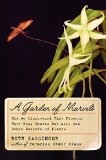Summary | Excerpt | Reading Guide | Reviews | Beyond the Book | Readalikes | Genres & Themes | Author Bio
How We Discovered that Flowers Have Sex, Leaves Eat Air, and Other Secrets of Plants

Critics' Opinion:
Readers' Opinion:
First Published:
Feb 2014, 416 pages
Paperback:
Mar 2015, 416 pages
 Book Reviewed by:
Book Reviewed by:
Heather A Phillips
Buy This Book
Dean takes me outside to see one of the miscanthus fields descended from those rhizomes. From a distance, the field reminds me of the blocky mesas that rise abruptly out of the landscape in the American Southwest, except, instead of ochers and beiges, here the hues are emerald and dark green. As we approach, the mesa reveals itself to be a dense mass of vertical canes well clothed in bladelike leaves. The whole assemblage sways and shivers in the morning's brisk breeze. Dean urges me to stay back a minute to take a photograph, and he strides ahead to position himself at the front edge of the field. With Dean in the photo, it is clear that the plants are already nearly twice his six-foot height, and it is only mid-July. Giganteus, indeed.
When Dean and I stand at the edge of the field to look more closely at the plants, I can see that the leaves, dark green with a thin, white stripe down the midline, emerge at every joint of a segmented cane. With two hands, Dean grabs a cane near its base and, tugging hard, pulls it out of the ground, along with its subterranean anchor. He is careful not to grab the leaves, which are covered in microscopic silica, a deterrent to insects and small herbivores. (He recently got in trouble with his wife, he tells me sheepishly, for letting their two youngest sons play hide-and- seek in a miscanthus field. When his wife put the boys in a bath with Epsom salts that evening, they shrieked with the sting from invisible cuts.) He snaps off the cane and hands me what looks like a piece of thick, gnarly root about eight inches long. It's not really a root, he explains, but a rhizome, a stem that grows horizontally underground. The rhizome is segmented, and each segment or node has a large and stubby bud. The buds are capable of producing either a new rhizome, a fibrous root, or a new cane, depending on the hormonal signal they receive. Over time, many of the buds will become new canes.
Although it is the tough canes that are harvested for biofuel, it is miscanthus's leaves that are key to its success. Grasses are newcomers to the planet's flora, coming on the scene just as the dinosaurs vanished 65 million years ago at the end of the Cretaceous. No one knows for sure why they evolved so late in the geologic day, but climate change likely played a role. At the time, the higher latitudes in the continents' interiors were becoming more arid and fires more frequent. Grasses are well adapted to fire because their growing tips are at or even below ground level where, sheltered from flames, they can regenerate that very season. Trees, on the other hand, are either killed outright or take years to recover.
The evolution of large mammals in the post-Cretaceous era also helped the grasses evolve. By 55 million years ago, grazing hoofed animals, the ancestors of modern horses, antelopes, cattle, and camels, were clipping the tender tips of shrubby plants and small trees, stunting or killing them and opening more territory for grasses. Grazing animals might munch grasses to the ground, but when the herd moved on, the grasses sprang up again. By ten million years ago, temperate regions were covered in vast grasslands much like the modern prairies of North America, steppes of Eurasia, pampas of South America, and veldt of southern Africa.
About that time, in hotter, drier environments closer to the equator, a new class of grasses, what you might call supergrasses, proliferated. These species are today's critical food crops of sugarcane, corn, millet, and sorghum, as well as bamboo and (ta-da!) miscanthus. The key to their success was their reinvention of photosynthesis. Most plants and the older grasses photosynthesize in a "C3" fashion, and as successful as they were and are, they have a physiological weakness. One of the steps in fixing atmospheric carbon dioxide into sugars involves the enzyme RuBisCO. But, RuBisCO regularly makes a mistake and fixes oxygen instead of carbon dioxide. The plant then needs to shed that oxygen, and in doing so, loses some carbon it recently trapped. In hot weather, the problem gets worse. When plants need to conserve water—that is, when they are losing more water through evaporation from their leaves than their roots can replace—their stomata automatically close. When the stomata close, waste oxygen can't escape and accumulates—and is fixed by RuBisCO—in the leaves. In hot conditions, C3 plants make fewer sugars.
Excerpted from A Garden of Marvels by Ruth Kassinger. Copyright © 2014 by Ruth Kassinger. Excerpted by permission of William Morrow. All rights reserved. No part of this excerpt may be reproduced or reprinted without permission in writing from the publisher.




A classic is a book that has never finished saying what it has to say
Click Here to find out who said this, as well as discovering other famous literary quotes!
Your guide toexceptional books
BookBrowse seeks out and recommends the best in contemporary fiction and nonfiction—books that not only engage and entertain but also deepen our understanding of ourselves and the world around us.